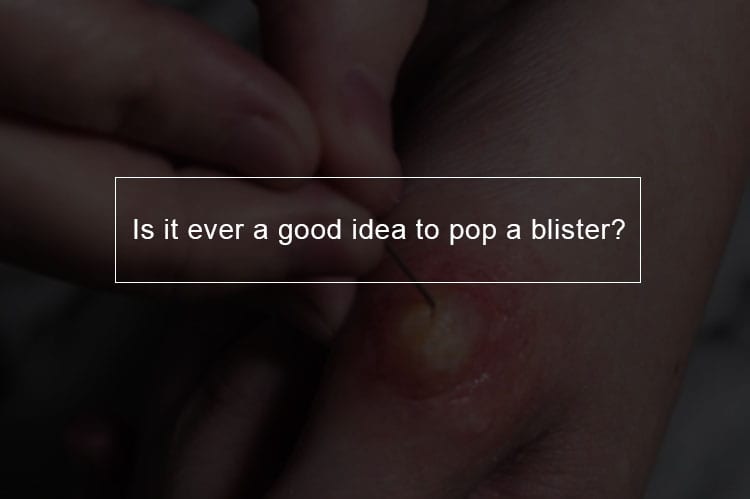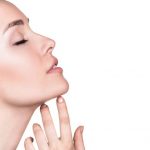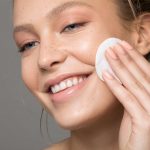
Blisters are raised bubbles beneath the epidermis- your top layer of skin that contains fluid. This fluid might be pus, clear liquid, or blood. Regardless of what's inside them, blisters can be very uncomfortable, especially if they’re on the part of your body that you frequently use. You probably know that it’s best to leave blisters alone. Even though this is true, it’s not always practical. Read on to find out how to know when you may have to do things on your own and how to do it carefully.
How do I safely pop a blister?
If you have friction or blood blister in a frequently used region that has a high affinity of rupturing by itself, it may be best to pop it yourself to ensure you protect adequately against infection.
Just remember that blisters usually heal on their own within a few days. Bursting a blister disrupts this natural process, and it could mean that your blister will take a little longer to disappear completely. You’ll also need to closely monitor on it after you pop it to watch for signs of infection.
If you’re opting for a quick, easy fix, your best choice is to let the blister run its course. For extra protection, you can use moleskin to the blister. Learn how to use it.
But if you do need to burst a blister, follow these steps to reduce your risk of infection or other conditions:
- Use a sterilized needle (to purify it, place the edge or point in a flame until it is red hot, or wash it off in alcohol).
- Wash your hands and the part thoroughly, then make a small hole; the fluid will drain on its own.
- If the fluid is yellow or white, the blister may be infected and requires medical care.
- Do not peel the skin that's covering a broken blister. The new skin below needs this protective layer.
- Spread an antibiotic cream or ointment.
- Look for signs of infection to develop, such as pus drainage, reddish or warm skin around the blister, or red streaks moving away from the blister.
Before popping a blister, it’s essential first to determine what kind of blister you have. While all blisters share some standard features, they aren’t all good candidates for popping on your own.
Popping a friction blister
Friction blisters are as a result of repeated pressure or rubbing, which leads to irritation. They can develop from wearing shoes that don’t fit properly, especially if they’re too tight. While they can grow in any part that comes into contact with friction, the hands and feet are common sites.
Immediately you eliminate the source of friction, and the fluid drains typically on its own within a few days. You’ll then form a new layer of skin under the blister once the skin surface develops, the skin from the first blister will drop off.
If you maintain the friction on the blister, it can take several weeks to heal. Meanwhile, the blister may pop on its own, oozing fluid. It also leaves the blister susceptible to contamination. If you suffer from a friction blister that you can’t guard against irritation, for example, one on the index finger of the hand you regularly use, you might want to consider safely popping it to steer clear infection.
Popping a blood blister
Blood blisters are friction blisters that have a mix of clear fluid and blood. They’re usually red when they first form. Over time, they can become more purple. The blood originates from broken blood vessels below the raised pocket of skin.
Even though they look slightly different, blood blisters and friction blisters follow the same course of healing, and you can treat them in the same way similarly. You should only burst a blood blister if you didn't avoid using the affected region.
Popping a fever blister
Fever blisters aka cold sores are red blisters filled with fluid. They develop on the face, generally around the mouth. They can also form on your fingers on the nose, or inside the mouth. Some fever blisters often form together like a clump.
Fever blisters are as a result of the herpes simplex virus, which quickly spreads to others through close contact. Never pop a fever blister. It won’t assist it in healing any faster, and you run the risk of spreading the virus to other parts of your skin or other individuals.
Is there a Risk Of Popping Blisters On The Feet?
Dealing with a foot blister pain, the inconvenience of blister treatment and the downtime in waiting for it to resolve is already awful. But infection is a whole different story. It makes your blister sorer, requires more of your attention and things can escalate quickly. So you need medical assistance next to you. And the fact is, while they're tucked away in your shoes, feet spend a lot of time in a dirty, dark, warm, moist surrounding that lends itself to bacterial infection. And when not in shoes, our feet are what lets us make contact with the ground - a source of countless germs. So foot blisters are especially susceptible to infection.
Is My Blister Infected?
How Will I Know My Blister Has Infections?
Popped blisters are more susceptible to infections than blisters that are left to heal on their own. In case you pop a blister, ensure you're observant to any signs of a disease, such as:
- swelling around the blister
- pus draining out of the blister
- the skin around the blister that’s warm to the touch
- a foul smell coming from the blister
- pain around the blister
In case you notice any of the signs above, visit a doctor pronto to prevent the infection from increasing in severity. You can also follow up with a doctor if the part doesn’t seem to be healing at all after a day or two.
Popping a blister: Time to Call a Doctor
In case red streaks start spreading around your blister and upwards, you need to seek urgent medical attention. It is a condition known as lymphangitis (commonly but wrongly referred to as blood-borne infection or blood poisoning). It is a severe medical condition. If you don't monitor it, contamination can even lead to severe systemic reactions and death. Sometimes a blister is not just a blister. For example, if you can't figure out where your blisters are coming from, they could be related to diabetes or blood-circulation issues—and you need to see your doctor. Also, if your blister turns red, continues to swell, or the pain increases, it could be infected. That requires a doctor's prompt attention. Ditto if your blister seeps fluid for more than five days.
How do I get rid of blisters fast?
They might be hard to prevent, but they are a cinch to cure. These treatments can offer relief for the most painful blisters on your feet and other body parts.
Use deodorant to keep the blisters dry. Blisters are worsened by friction and moisture, so keeping your feet dry can assist prevent them from occurring. Apply the gel around the sides and tops of clean, dry feet before wearing a new pair of shoes; the deodorant acts as a home remedy to lubricate any problem regions and decrease rubbing. But in case you do get one, the treatments outlined below will help to treat your blister.
Cover it with a bandage. Bandages decrease friction and shield your blister from irritating contact. However, how you use them can affect how to treat blisters. To use a Band-Aid for blister treatment- Make a mini “tent” by applying the sticky ends of the bandage closer together, with the middle padded part rising slightly over your blister. This home treatment enables the blister to breathe, thus fastening the healing process while also protecting it from dirt or friction and debris that could result in infection.
Soak the blister in green tea - Green tea contains anti-inflammatory values that promote healing. This is how to get rid of blisters with green tea: Brew three tea bags in boiling water, then toss in a teaspoon of baking soda (for its antiseptic attributes). Enable the brew to cool, then soak your blister in it. You can use gauze to rub the home remedy to the area in case the blister is in a region too difficult to soak. Also, in case your blister has not popped, you can speed up the healing procedure by soaking it in warm water to assist it to soften up and drain the fluid inside.
Apply apple cider vinegar - Be careful when applying apple cider vinegar on the blister as it might sting! However, it is a blister treatment worth trying, since apple cider vinegar has antibacterial attributes that will assist prevent a popped blister from getting infected. In case the vinegar home treatment is too painful, try cleaning the area with hydrogen peroxide and covering with an antibacterial cream.
Apply vitamin E - Vitamin E has great skin-repairing values, as it assists skin cells in healing faster and prevents scarring. You can buy vitamin E oil or creams or opt to pop open a vitamin E pill and rub the liquid directly to your blistered skin.
Apply castor oil - Castor oil is a well-known home treatment for blister. How to get rid of blisters with castor oil: Rub castor oil before you go to bed, and allow it to sit overnight to assist your blister in drying up and heal. You can combine the castor oil with apple cider vinegar to promote further healing.
Use aloe vera gel - Aloe has anti-inflammatory properties, so it will assist decrease swelling and redness that result in pain. Medical studies have also proven that aloe vera is as effective as traditional medication in healing second- and third-degree burns, making it a perfect home remedy for blisters.




